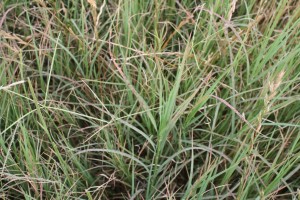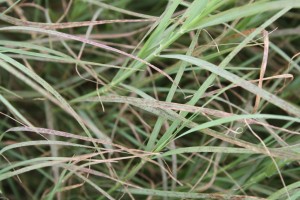I have observed bermudagrass leafspot/rust in several commercial hayfields of Russell Bermudagrass in Holmes County over the last few weeks. Typically this is something that is observed later in the growing season during hot, humid weather. Even though Russell is thought to have good resistance to leafspot sometimes resistant varieties can still be infected with leaf diseases, particularly when soil fertility is low. Included is some information on bermudagrass leafspot from the University of Georgia.
The severity of leaf spot can be minimized using management practices once the stand is established. The most important practice is to sample soil and maintain adequate levels of fertility. Soil potassium is critical for leaf spot resistance. Most reported leaf spot cases are directly related to low soil potash. Nutrients are removed from bermudagrass hay fields in approximately a 4-1-3 ratio of N, P2O5, and K2O with hay harvest. That means that 75 percent as much potash as nitrogen should be applied each season. Please note that soil tests can be misleading. In Georgia there have been cases where adequate soil levels were present, but plant tissue samples indicate a nutrient deficiency.
In the twenty acre field where these pictures were taken, the farmer had applied 80 lb of potash per acre with his initial application of nitrogen for the hay season. However, our growing conditions have been very dry, resulting in poor nutrient uptake in this field. Soil test levels of potassium were in the edge of medium in this case.
Thatch buildup can also contribute to leafspot development in bermudagrass. Some leaf spot infections appear to be associated with the amount of thatch present in hay fields, with heavy thatch loads producing higher incidences of leaf spot. Thatch ties up nutrients and contains abundant decaying material, which may serve as a “spore reservoir.” In addition, thatch retains water and reduces air circulation, creating humid conditions and promoting leaf spot incidence. The only practical way to reduce thatch is to burn in the months just prior to bermudagrass green-up.
Submitted by Shep Eubanks, Holmes County Extension Director
 0
0


